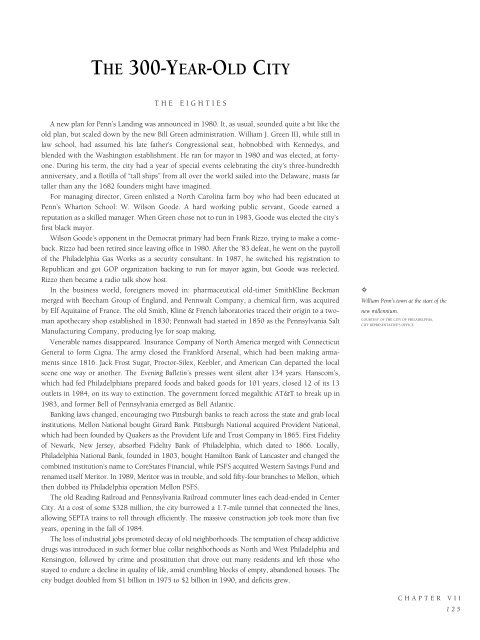Historic Philadelphia
An illustrated history of the city of Philadelphia, paired with the histories of companies, families and organizations that make the region great.
An illustrated history of the city of Philadelphia, paired with the histories of companies, families and organizations that make the region great.
You also want an ePaper? Increase the reach of your titles
YUMPU automatically turns print PDFs into web optimized ePapers that Google loves.
THE 300-YEAR-OLD CITY<br />
THE<br />
EIGHTIES<br />
A new plan for Penn’s Landing was announced in 1980. It, as usual, sounded quite a bit like the<br />
old plan, but scaled down by the new Bill Green administration. William J. Green III, while still in<br />
law school, had assumed his late father’s Congressional seat, hobnobbed with Kennedys, and<br />
blended with the Washington establishment. He ran for mayor in 1980 and was elected, at fortyone.<br />
During his term, the city had a year of special events celebrating the city’s three-hundredth<br />
anniversary, and a flotilla of “tall ships” from all over the world sailed into the Delaware, masts far<br />
taller than any the 1682 founders might have imagined.<br />
For managing director, Green enlisted a North Carolina farm boy who had been educated at<br />
Penn’s Wharton School: W. Wilson Goode. A hard working public servant, Goode earned a<br />
reputation as a skilled manager. When Green chose not to run in 1983, Goode was elected the city’s<br />
first black mayor.<br />
Wilson Goode’s opponent in the Democrat primary had been Frank Rizzo, trying to make a comeback.<br />
Rizzo had been retired since leaving office in 1980. After the ’83 defeat, he went on the payroll<br />
of the <strong>Philadelphia</strong> Gas Works as a security consultant. In 1987, he switched his registration to<br />
Republican and got GOP organization backing to run for mayor again, but Goode was reelected.<br />
Rizzo then became a radio talk show host.<br />
In the business world, foreigners moved in: pharmaceutical old-timer SmithKline Beckman<br />
merged with Beecham Group of England, and Pennwalt Company, a chemical firm, was acquired<br />
by Elf Aquitaine of France. The old Smith, Kline & French laboratories traced their origin to a twoman<br />
apothecary shop established in 1830; Pennwalt had started in 1850 as the Pennsylvania Salt<br />
Manufacturing Company, producing lye for soap making.<br />
Venerable names disappeared. Insurance Company of North America merged with Connecticut<br />
General to form Cigna. The army closed the Frankford Arsenal, which had been making armaments<br />
since 1816. Jack Frost Sugar, Proctor-Silex, Keebler, and American Can departed the local<br />
scene one way or another. The Evening Bulletin’s presses went silent after 134 years. Hanscom’s,<br />
which had fed <strong>Philadelphia</strong>ns prepared foods and baked goods for 101 years, closed 12 of its 13<br />
outlets in 1984, on its way to extinction. The government forced megalithic AT&T to break up in<br />
1983, and former Bell of Pennsylvania emerged as Bell Atlantic.<br />
Banking laws changed, encouraging two Pittsburgh banks to reach across the state and grab local<br />
institutions. Mellon National bought Girard Bank. Pittsburgh National acquired Provident National,<br />
which had been founded by Quakers as the Provident Life and Trust Company in 1865. First Fidelity<br />
of Newark, New Jersey, absorbed Fidelity Bank of <strong>Philadelphia</strong>, which dated to 1866. Locally,<br />
<strong>Philadelphia</strong> National Bank, founded in 1803, bought Hamilton Bank of Lancaster and changed the<br />
combined institution’s name to CoreStates Financial, while PSFS acquired Western Savings Fund and<br />
renamed itself Meritor. In 1989, Meritor was in trouble, and sold fifty-four branches to Mellon, which<br />
then dubbed its <strong>Philadelphia</strong> operation Mellon PSFS.<br />
The old Reading Railroad and Pennsylvania Railroad commuter lines each dead-ended in Center<br />
City. At a cost of some $328 million, the city burrowed a 1.7-mile tunnel that connected the lines,<br />
allowing SEPTA trains to roll through efficiently. The massive construction job took more than five<br />
years, opening in the fall of 1984.<br />
The loss of industrial jobs promoted decay of old neighborhoods. The temptation of cheap addictive<br />
drugs was introduced in such former blue collar neighborhoods as North and West <strong>Philadelphia</strong> and<br />
Kensington, followed by crime and prostitution that drove out many residents and left those who<br />
stayed to endure a decline in quality of life, amid crumbling blocks of empty, abandoned houses. The<br />
city budget doubled from $1 billion in 1975 to $2 billion in 1990, and deficits grew.<br />
✧<br />
William Penn’s town at the start of the<br />
new millennium.<br />
COURTESY OF THE CITY OF PHILADELPHIA,<br />
CITY REPRESENTATIVE’S OFFICE.<br />
CHAPTER VII<br />
125
















